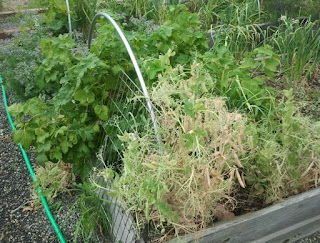Why do we have seed tray here filled with garden soil? would not bugs damage the seedlings, would not it be better to buy soil only because it was specially made?
As a matter of fact this is the old way of avoiding soil transplant shock. The baby plant does not 'know' it is going to be transplanted...
From here
to the garden. Store bought soil is not going to be alkaline like what we have here. Young plants in our case need to be trained and helped and form symbiotic relationship with bacteria, fungi, protozoa etc life forms of the soil so they can put proper foods through the roots, if they are in stero soil they put out one thing and that's ok for growing seedling trees on large commercial scale.In home garden one gets stunted transplants here not only because sun is aggressive in high altitude desert but also because garden centers will sell 6.0 soil, and 7.5+ or 8.5+ is a big difference.
If garden soil was replaced it's not a bad idea to use that in your seedlings potting mix.
What that's going to do is to teach the baby plant what live forms are coming with it.
when it comes to seedlings one does not need expensive grow lights.
These are shop lights and cinder blocks. as plants get a bit bigger lights go more up
One needs to keep the lights close and move them up as plants grow. These are full spectrum shop lights. thenit;s time to turn cinder block on it's side from horizontal to vertical. and we keep growing.
And tarp is underneath. all that cal live under your dining room table :) or in basement, or where ever there is a spot when one does not have a green house.
This is double tarp (new one) above expensive solid hardwood. No floors were ever damaged with that method, because I do not like replacing those either :).
It does save a lot to start from seeds. We are talking $2+ per tomato plant.
The garden succession retrospective. Experiments with peas continued.
to gardens we go...
This is early spring, peas go in in March or earlier depending on the weather, they are not going to come up if to cold, they do fine with snow, or hail. We get snow in mid May or there were years even in June.
This is 2014 04. Lettuces are in., they are succeeded by cucumbers and onions and melons. Trelluses went up, stronger ones.
and 2016 04 hail storm
and month later it is all fine. 2016 05

Spring radish
these can go in in February under row covers or even can overwinter, daicon sure did.
Peas were planted like above in rows (outer side of it I liked better)
I also liked these planted before peppers go in.
Some ended up having last season potatoes... how did that happen....
Anyways, peppers were planted into this bed and did fine.
So we start like this with peas, tomatoes gets planted towards the support and trained on that later in season, peas go in March (last frost/snow is May 20 something ...)
But last year I took it and had enough plastic containers for mini green houses and tomatoes-peppers went in May 15-th week in 2016 , this year I'm armed with wall-o-water things :)
So because the tomatoes was trained to go in trellises peas are outside we end up with something like this in mid succession. They do not compete much, tomatoes during transplant were part shaded by peas so they did not get too bad of a sun hit (human can get a decent sun burn here in our high altitude in 15 min)
Here is anotherPeas...
Later weeks are like so, peas get folded and fully dry in 07.
or pushed out
Here is another perspective of folded peas from another year about 06 or so. These peas did produce, now they are shielding the ground and cooling it as living mulch. We are looking at dead heat waves in 85+F when things... do not grow, they dry out, also dry winds come this time of the year.
Size of peas pulled out for seeds.
It all end up all right so. All plants form symbiotic relationships and are happy.
And chickens help to clean seeds I did not.
Borrage helps to attract bees and self seeds, I have plenty of that now and started with tiny $2 seed pack. I'd say this was successful pollinator plant.
Hive bees love it, wild midwest beet love it, it's overall a good plant.
It comes with additional benefit when grown on outer side of the fence and protects grapes from over hungry chickens. One has to cover and mulch it... or have a rocks mulch a bit. Chickens seem to like borrage seeds and go dig for them. I do not worry, I have enough volunteers I can transplant from garden beds to outer perimeter.
I do keep some borrage in garden as one can see. I keep ones that sort of spill into between the rows area.


















Very enlightening, thank you!
ReplyDelete